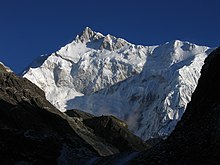 | ||
| Mt. Kangchanjunga, Nepal |
In a blogpost of April, 2015 titled Meditative Attainments: Four Views of Nirvana, I described four views of Nirvana from different traditions. After spending the last half year studying Nagrajuna's Mulamadhyamakakarika, I think I now understand a fifth view, or maybe lack of view is a better way to put it. Because that is what Nagarjuna's view of nirvana is, the lack of any fixed view at all.
It's difficult to see how this could be possible. Language forces our thinking into classifying the world into objects and what they do, nouns and verbs, with prepositions acting as a kind of relational glue. This observation provides the first hint about one property of this non-view: it is difficult to describe in language. And, to the extent we use language to communicate, the non-view of no fixed view is difficult to communicate at all. The commentators to the Karikas nevertheless felt that the Buddha and other enlightened beings have to communicate with students about what liberation is like, and so they have to use some kind of language.
From the Theravada/Early Buddhist perspective, the Buddha's teaching is all about abandoning desire and aversion through the realization that the self is just a constructed entity and not something fixed. This realization does not come easy. The deep altered states of consciousness coming from the path and fruit (magga and phala) moments in the four stages of enlightenment are needed to sever the bonds between sense perception and the constructed entity of the self. Wynne in his excellent essay "Early Buddhist Teaching as Proto-sunyavada" describes this as "no-self".
Nagarjuna's view which is based on some threads in the Nikayas from the Buddha's teaching, is that, actually, the whole world is a cognitive construction, just like the feeling of self. This isn't to suppose that Nagarjuna was a solipsist or a subjective idealist, in other words, that he believed there is no reality outside of his mind. Rather, his position is that there is an objective reality, but we can never know it as more than an approximation. That's because we construct a view of objective reality from our sense data and the cognitive context we bring to that data. The sense data is constrained by the kinds of events our sense organs can experience. For example, some bees can see into the ultraviolet but humans can't, so bees have a different view of the world than we do. The cognitive context contains such properties as our gender, our native language and any other languages in which we are fluent, our culture, the time and place in which our lives play out, and so forth.
These properties and our limited sense data cause us to interpret the world in particular ways that, if they were to occur to someone else, say a women from the 25th century with genetic enhancements that allow her to see into the ultraviolet who was raised on Mars or a monk from 200 BC India who achieved liberation on the banks of the Niranjara River (aka the Buddha), would result in a different interpretation. Complete liberation from the process by which we construct reality from sense data and our cognitive context seems unlikely to be possible on a permanent basis, though I believe it is possible to experience the constructed nature of reality just like it is possible to experience the constructed nature of the self, through meditation. Being able to realize the constructed nature of our views on reality and treating them lightly, as a hypothesis, rather than as a fixed, immovable, universal, and unending truth is what I believe is Nagarjuna's Fifth View of Nirvana.
Image source:wikipedia.com
